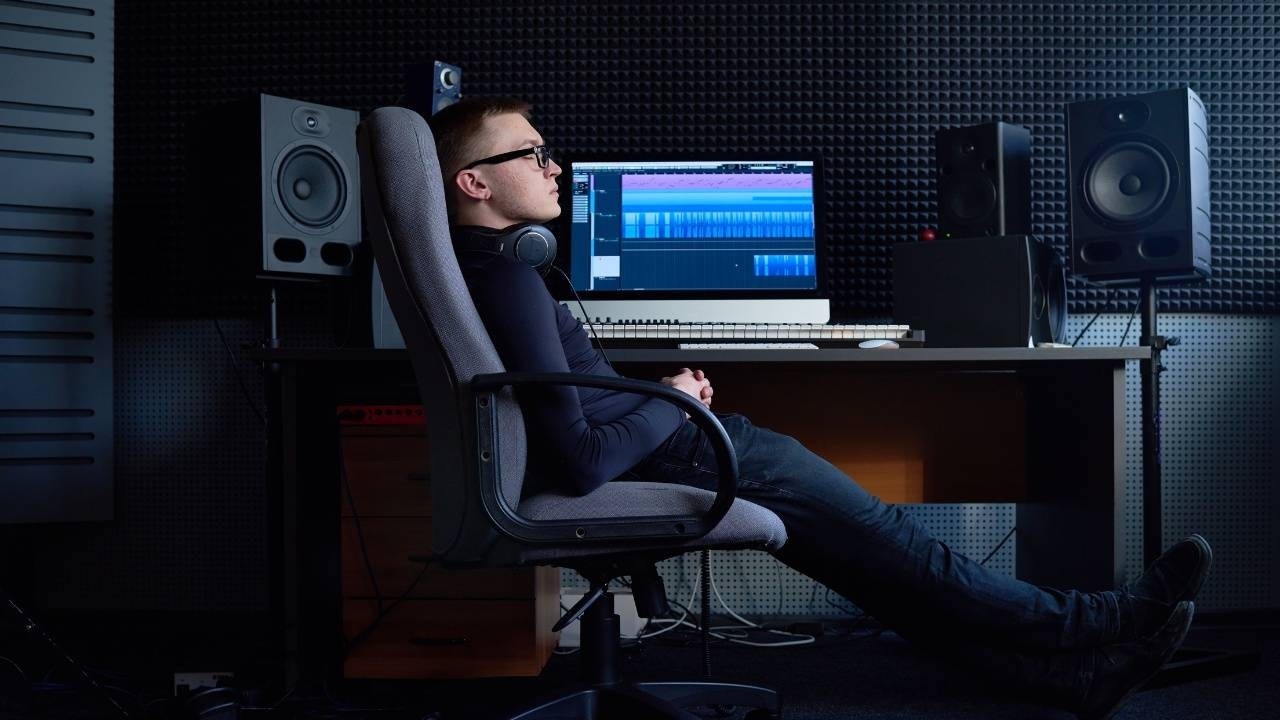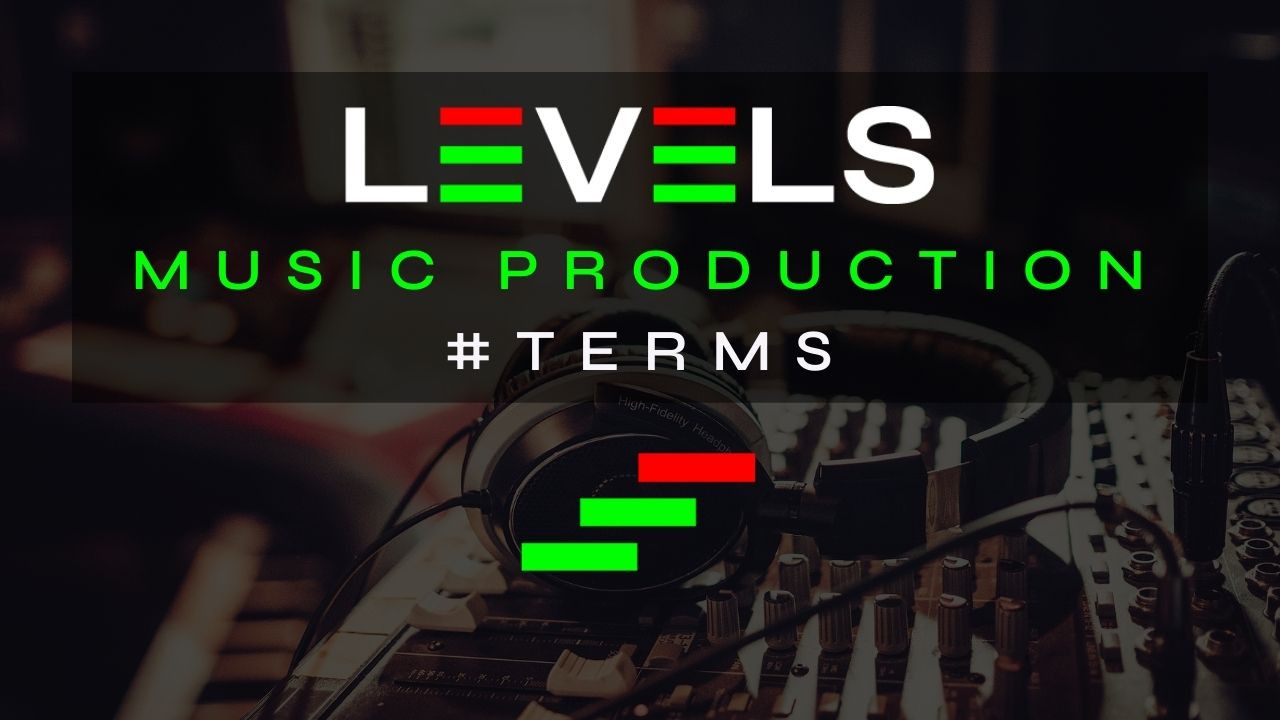111 Confusing Sound Recording and Music Production Terms Translated

Learning the Language
I get it - Every time you try to learn about recording and music production people are throwing around these crazy terms like 44.1kHz, condenser, phantom power, mix buss, headroom, phase, aux send, and unity gain. In this blog post, I'll break down some of these terms for you so you can focus on making music. This is my personal take on these terms. I wanted to give you my simplified interpretation of some difficult music production terminology. These are NOT the official dictionary definitions.
The Presentation
Instead of listing these terms alphabetically, I've decided to try to group together terms that somehow connect with each other. Of course, ultimately they’re all connected. I hope this format helps to paint a picture of the recording process and its internal signal flow.
"If you want the find the secrets of the universe, think in terms of energy, frequency and vibration."
- Nikola Tesla
Every day I'm blown away by the accuracy of this quote and its importance to sound recording, music production and life. Notice how many times you see it connect the following 111 terms together...
Frequency
The speed at which a sound is vibrating. Translates to the pitch of a musical note.
Hz & kHz
How frequency is measured in cycles per second. Hertz and KiloHertz. 1kHz = 1000 cps.
Cycle
One complete rotation of a sound frequency vibration.
Phase
The location of a sound's cycle, usually in relation to another sound's cycle.
Polarity
The positive and negative orientation of a sound vibration waveform.
dB
The loudness or sound pressure level of a sound measured in decibels.
Level
The amount of sound voltage travelling through the audio components.
EQ
Frequency equalization that allows you to balance or adjust the tone of each sound.
Analog Sound
Physical sound vibrations sent and received by transducers via air, electricity and electronics.
Transducer
Something that changes one form of energy to another. (ears, speakers, microphones, etc.)
Digital Audio
Analog sounds converted to zeros and ones and then stored on a hard drive.
A/D & D/A Converter
The part of your Audio Interface that converts analog to digital and digital back to analog.
Mic
Short for microphone. A transducer that converts sound waves into electrical impulses.
Speaker / Monitors
A transducer that does the opposite of a mic. Left and right speakers create a stereo image.
Phantom Power / +48V
Power for condenser mics that flows backwards through a mic cable from the preamp.
Pre-Amp
A pre-amplifier boosts the level of a mic or instrument level signal to a louder line level.
Line / Line Level
The input type and level at which professional audio gear operates.
Mic Level
The level at which microphones operate. Requires a pre-amp to boost the signal up to line level.
Instrument Level
The quietest of the 3 input levels. Requires the use of an amplifier or DI box to boost the signal.
DI Box
Converts instrument level signals to mic level or balances unbalanced line level signals.
Balanced
A 3-conductor cable, jack or signal type that is less susceptible to noise.
Unbalanced
A 2-conductor cable, jack or signal type that is more susceptible to noise.
Amp / Amplifier
An electronic circuit used to increase the volume level of a signal. Used with a speaker.
Volume
The loudness level of a line level signal that has been amplified.

Audio Interface
Controls input level, converts between analog & digital, and provides monitoring options.
Input
The intake signal path to each audio component.
Output
The exit signal path from each audio component.
Monitor Mix
Controls the amount of direct input source sound compared to the recorded sound output.
DAW
Digital Audio Workstation. Software that lets you record, edit and mix music digitally.
Audio File
A digital sound recording stored on your computer. It can be an instrument, a vocal or a full song.
.WAV or AIFF File
Two popular formats for audio files saved to your computer.
Stereo Interleaved
A single audio file that contains both left and right channels of stereo audio.
MIDI
Digital information that emulates musical parts or performances.
Synthesizer
An analog or digital electronic instrument that can emulate real instruments or other sounds.
Soft Synth
A software synthesizer that emulates instruments, synthesizers or other sounds.
Plugin
A soft synth or audio effect device inserted into the channel of a DAW.
Instruments, Audio / MIDI Effects
Native effects and soft synths that are included as part of your DAW.
VST / AU / AAX
3 different types of 3rd party plugins that certain DAWs can host.
Sampler
A device that can play back and manipulate sound recordings.
Samples
Sound recordings that can be played back in a sampler.
Sample Rate
The number of snapshots used to digitally capture sound.
44.1 kHz
One of the 2 most used sample rates. Takes 44100 snapshots per second.
48 kHz
One of the 2 most used sample rates. Takes 48000 snapshots per second.
Bit Depth
Audio resolution that determines the quality of the digital recording.
Live Set / Session File
A small file that contains all of the information for the song but does not contain any audio.
Save
Song set/session file and audio files are organized into one main folder.
Save As...
A new version of the song's set/session file is created and kept in the same main folder.
Save Copy
The whole session and the contents of its folder are duplicated.
Signal
The audio level that is seen visually with meters as it flows through the audio components.
Track
A single performance saved as an audio file or MIDI and MIDI instrument saved in your DAW.
Recording Channel
The audio component sections that a signal flows through during recording.
Mixer
Combines the outputs of all tracks and any effects into the master left and right output.
Recording / Mixing Console
A matrix of input and output channels and used for recording and/or mixing.
Monitor Level
The listening volume level of the monitors. It is fed by the master fader or 2-track sources.

2-Track Return
A stereo reference input that takes the place of the master and is sent to the monitors.
Talkback Button & Mic
When pressed, the producer can speak to anyone wearing headphones.
Parallel Effects
Effects that are processed and return on their own separate channel.
Series or Insert Effects
An effect that is processed directly on the same channel as the signal.
Insert
The send & return connections used to add a series effect to any channel.
Direct Out
Sends the signal from the input channel to the track of the same number.
Buss
Can combine channel signals and/or connect the input channels to the audio interface.
Mix Buss / Master Fader
The main left and right output of a mixer. Mix audio exports and monitor signals pass through it.
Aux Send
Parallel channel sends that allow alternate mixes for headphones or parallel effects.
Aux Master
The master control for each aux send. The channel aux sends pass through it.
Wet / Dry Mix
The balance of original audio vs the audio effects.
Signal Chain
The order in which multiple series effects and channel components are connected.
Gain
Another word for the level of your audio signal during or after recording.
Unity Gain
Matching the input and output levels between audio devices.
Device
A MIDI effect, instrument, or audio effect component for audio or MIDI tracks.
Signal Flow
The path and direction of the audio as it moves through the audio components.
Meter
A visual representation of the audio levels. It can indicate peak or average levels.
Clipping
When the green signal meters go into the red, warning of potential digital audio distortion.
Digital Distortion
The typically unpleasant overloading of the audio level going above 0dB.
0dB
The maximum level that can be recorded digitally before distortion occurs.
Headroom
The amount of extra room you leave for your audio levels below 0dB.
Gain Staging
Adjusting and optimizing the input and output levels flowing through each audio component.
Attack
The time it takes a sound to reach its maximum volume level after starting from silence.
Decay
The amount of time it takes for a sound to go back down from its maximum peak to average level.
Sustain
The amount of time a sound maintains its average volume level.
Release
The time it takes a sound to return back to silence from the average volume level.
Envelope
The shape of a sound (or another action) over time. Divided into ADS&R.
Transient
A peak in the audio level that is usually caused by the initial hit or attack of the sound.
Dynamic Processor
An effects processor that controls the volume level. (compressor, limiter, gate, expander, de-esser)

De-Esser
A frequency specific compressor typically used to control high midrange vocal frequencies.
Compressor
A dynamic processor that controls the peak levels and increases the quieter levels.
Limiter
A compressor with a higher ratio (amount) used for more intense peak control.
Noise Gate
A dynamic processor that mutes quiet signals (like noise) when there is no main signal present.
Expander
Two types: A noise gate that only reduces instead of muting or the opposite of a compressor.
Threshold
Signal levels below the threshold line do not get compressed while the levels above it do.
Ratio
The amount of compression that happens after a signal crosses above the threshold. (2:1, 4:1, etc.)
Bypass
Allows the unprocessed (dry) signal to pass through the audio component / effect processor.
Knee
The transition intensity in a dynamic processor. Soft is more natural than hard.
Attack Time
The time it takes for a dynamic processor to start affecting the signal after the threshold is met.
Release Time
The time it takes to stop affecting the signal after it falls below the threshold.
Input Gain
The signal that is fed into the audio component / effects processor.
Output / Makeup Gain
The signal level coming out of the effects processor.
Fader
A resistor that attenuates the level of a line level signal below its zero reference point.
Pan
A panorama control positions a sound anywhere between the left and right speakers.
Stereo
The use of two speakers to create a binaural (two ears) listening experience.
Mono
When the left and right speaker output is identical resulting in a single central point of sound.
Mute
A button that cuts a mixer channel's sound from going to the master, thereby silencing it.
Solo
An isolate button for a single mixer channel. It can be set to allow single or multiple solos.
Input Monitor
Allows you hear the input of a signal being sent to a record- enabled track at all times.
Auto-Input
Same as above except during playback, in which case the track recording is heard instead.
Cue
This can refer to a headphone mix or the act of finding the starting point of a song section.
Dynamic
A type of microphone that is durable and less sensitive than a condenser.
Condenser
A type of microphone that is typically brighter and ironically more dynamic. They need power.
Pop Filter
A thin screen placed between the mic and sound source to diffuse plosives (blasts of air).
Frequency Response
The frequency range of a transducer (instrument, mic, speaker)
Frequency Band
A range of frequencies on an EQ. Typically divided into Low, Low Mid, Mid, High Mid, and High.
Filter
An EQ band that removes a certain range of frequencies and leaves the rest alone.
Download the PDF version of these 111 Music Production Terms
I hope this helped to clear up some confusing music production vocabulary. Music production is fun to learn but there seems like a lot of recording jargon to learn at times. You don't need to know it all right away. Just take your time and ask questions as they arise. Download the PDF version for reference. More FREE Music Production resources available here

Futch - Music Production Coach, Ableton Certified Trainer
#musicproduction #musicproductionterms #audioengineering #mixing #recording #sound #audio





